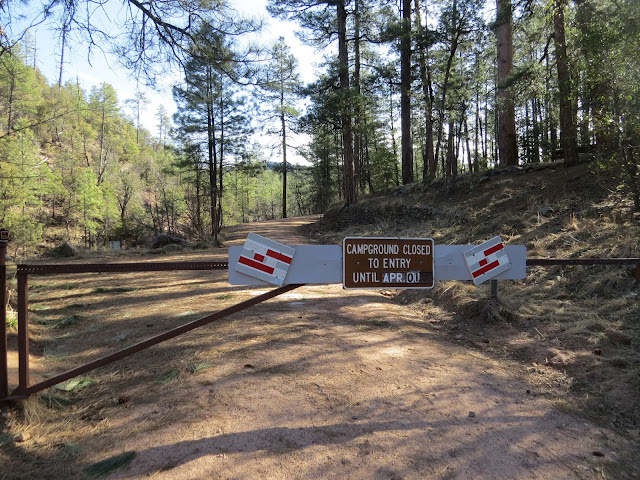I stayed in a campground in Payson and visited the Rim Country Museum and Zane Grey cabin. They do a wonderful guided tour of the museum, but they don't allow photos, so you'll just have to come yourself.
The Zane Grey cabin shown above is actually an historic replica of the author's cabin that was located just below the Mogollon Rim and burned in the Dude Fire in 1990.
I mention it because we're going to be hiking in the area where he wrote and on a trail he likely hiked.
Just a couple miles above our trailhead is the Tonto Creek Hatchery. Tonto Creek begins here and flows 60 miles to Roosevelt Lake. Horton Creek that we will hike beside today is a tributary flowing into Tonto creek.
You can do a self-guided tour of the fish hatchery, and it is worth the visit.
The trailhead to Horton Creek Trail is located inside this campground.
Unfortunately the campgrounds up here don't open until April, or I would have tried to camp here.But the trail is open. The first challenge is to cross Horton Creek without getting your feet wet!
I am back in the land of tall trees....very refreshing!
Can you smell the pine forest?
You can fish, but you have to release all you catch.
The water is swift and there are many opportunities to photograph the creek.So I did!
Oh, and lots of beautiful birds! This is a Stellar's Jay.
I could hear and see many birds that did not want their pictures taken.
This Raven flew over my head.
Some birds puzzled me, but I think this is a female Western Bluebird.
And maybe this is a Pygmy Nuthatch? If so, it's a new one for me.
Sometimes you could only glimpse the cascades through the trees below.
A cacophony of Red-shafted Flickers showing off their colorful plumage!
This is the male with the red moustache.
This is one of two females.
The creek spills over numerous limestone ledges...
Thistle sampled the water a few times.
Spilling over a large log...
That's snow on the left...a few patches were seen in shady places. I turned back shortly after this and didn't finish the trail all the way to Horton Spring. We were getting tired and it was another 4 miles back to the car.
I see on the map a shorter way to get to the spring from another highway, so maybe next time. Meanwhile, I thought this trail was awesome!
Long shadows...time to go home and rest, and maybe read the Zane Grey novel I picked up at the museum..."Under the Tonto Rim."










































































